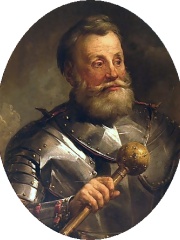
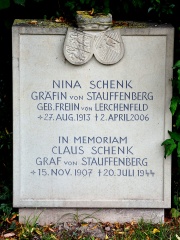

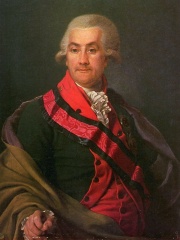
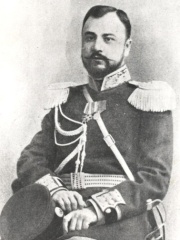
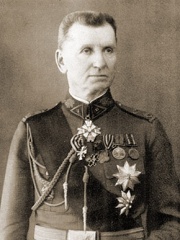
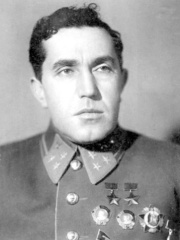
The Most Famous
MILITARY PERSONNELS from Lithuania
This page contains a list of the greatest Lithuanian Military Personnels. The pantheon dataset contains 2,058 Military Personnels, 8 of which were born in Lithuania. This makes Lithuania the birth place of the 35th most number of Military Personnels behind Hungary, and Egypt.
Top 8
The following people are considered by Pantheon to be the most legendary Lithuanian Military Personnels of all time. This list of famous Lithuanian Military Personnels is sorted by HPI (Historical Popularity Index), a metric that aggregates information on a biography's online popularity.

1. Jan Karol Chodkiewicz (1560 - 1621)
With an HPI of 68.37, Jan Karol Chodkiewicz is the most famous Lithuanian Military Personnel. His biography has been translated into 27 different languages on wikipedia.
Jan Karol Chodkiewicz (Lithuanian: Jonas Karolis Chodkevičius; c. 1561 – 24 September 1621) was a Polish–Lithuanian military commander of the Grand Ducal Lithuanian Army, who was from 1601 Field Hetman of Lithuania, and from 1605 Grand Hetman of Lithuania. He was one of the most prominent noblemen and military commanders of the Polish–Lithuanian Commonwealth of his era. His coat of arms was Chodkiewicz, as was his family name. He played a major role, often as the top commander of the military of the Polish-Lithuanian Commonwealth, in the Wallachian campaign of 1599–1601, the Polish–Swedish War of 1600–11, the Polish–Muscovite War of 1605–18, and the Polish–Ottoman War of 1620–1621. His most famous victory was the Battle of Kircholm in 1605, in which he dealt a major defeat to a Swedish army three times the size of his own. He died on the front lines during the battle of Khotyn, in the besieged Khotyn Fortress, a few days before the Ottomans gave up on the siege and agreed to negotiate.

2. Nina Schenk Gräfin von Stauffenberg (1913 - 2006)
With an HPI of 62.13, Nina Schenk Gräfin von Stauffenberg is the 2nd most famous Lithuanian Military Personnel. Her biography has been translated into 16 different languages.
Countess Nina von Stauffenberg (German: Elisabeth Magdalena Schenk Gräfin von Stauffenberg; born Elisabeth Magdalena Freiin von Lerchenfeld; 27 August 1913 – 2 April 2006) was the wife of Colonel Claus Schenk Graf von Stauffenberg, the leader of the failed plot to assassinate Adolf Hitler on 20 July 1944. Following the plot's failure and her husband's execution, she was arrested and imprisoned, during which time she delivered her youngest child.

3. Stanisław Bułak-Bałachowicz (1883 - 1940)
With an HPI of 60.95, Stanisław Bułak-Bałachowicz is the 3rd most famous Lithuanian Military Personnel. His biography has been translated into 17 different languages.
Stanisław Bułak-Bałachowicz (10 February 1883 – 10 May 1940) was a Polish-Belarusian general and veteran of World War I, the Russian Civil War, Estonian War of Independence, Polish-Soviet War, and the Invasion of Poland at the start of World War II.

4. Iosif Igelström (1737 - 1823)
With an HPI of 60.66, Iosif Igelström is the 4th most famous Lithuanian Military Personnel. His biography has been translated into 16 different languages.
Count Otto Heinrich Igelström (Swedish: Otto Henrik Igelström; Russian: Иосиф Андреевич Игельстром, romanized: Iosif Andreyevich Igelstrom; 7 May 1737 – 18 February 1823) was a Russian general from the noble Swedish family of Igelström, best known for his services during the Catherinian reign. His significant military victory was the siege of the Akkerman fortress in 1770. During the impressive Warsaw Uprising of 1794 Igelström lost control of his eventually defeated forces.
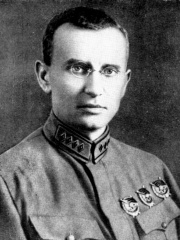
5. Ieronim Uborevich (1896 - 1937)
With an HPI of 60.62, Ieronim Uborevich is the 5th most famous Lithuanian Military Personnel. His biography has been translated into 22 different languages.
Ieronim Petrovich Uborevich (Lithuanian: Jeronimas Uborevičius; Russian: Иерони́м Петро́вич Уборе́вич; 14 January [O.S. 2 January] 1896 – 12 June 1937) was a Soviet military commander of the Red Army during the Russian Civil War, reaching the rank of komandarm in 1935. He was executed during the Great Purge in June 1937 and was posthumously rehabilitated in 1957.

6. Maciej Sulkiewicz (1865 - 1920)
With an HPI of 60.05, Maciej Sulkiewicz is the 6th most famous Lithuanian Military Personnel. His biography has been translated into 17 different languages.
Maciej (Suleyman bey) Sulkiewicz (Belarusian: Мацей Аляксандравіч Сулькевіч, romanized: Maciej Aliaksandravič Sulkievič, Azerbaijani: Süleyman bəy Sulkeviç, Russian: Матвей (Магомет) Сулькевич, romanized: Matvey (Magomet) Sulkevich; 20 June 1865 – 15 July 1920) was an Imperial Russian lieutenant general, Prime Minister of Crimean Regional Government (1918), and Chief of General Staff of Azerbaijani Armed Forces in 1918–20. Born to parents of Lipka Tatar origin, he changed his name to Mohammad after settling in Azerbaijan Democratic Republic, but in Azerbaijan he is still known as Suleyman bey Sulkiewicz and Mammad bey Sulkiewicz. He joined the Imperial Russian Army in 1883 and became an officer in 1886. He was promoted to major general in 1910 and to lieutenant general in 1915. Sulkiewicz participated in the Chinese expedition against the Boxers, in the Russo-Japanese War and World War I. Before the Russo–Japanese War he served in the Odessa Military District in 1894–1905 and served as a chief of staff at the Ochakov Fortress. During the Russo–Japanese War, Sulkiewicz fought at the Battle of Mukden as a member of the 8th Army Corps of the 2nd Manchurian Army, commanding the 57th Modlin Infantry Regiment. During his tour at the Far East, Sulkiewicz was honored with several orders of Imperial Russia such as the Order of Saint Anna, the Order of Saint Vladimir, and the Golden Weapon for Bravery. After the Russo–Japanese War, he remained in the Asian portion of Russia serving in the Irkutsk Military District. During the World War I, he fought at the Romanian Front. In the late 1917 Sulkiewicz was involved in creation of the 1st Muslim Army Corps, yet remained at the service of the Russian Romanian Front administration. Upon signing of the Treaty of Brest-Litovsk between the Soviet Russia and the Central powers, Sulkiewicz came to Crimea with the Central powers occupational forces which forced Bolshevik irregular formations out of Crimea and formed the Crimean Regional Government as interim government in Crimea under the German occupying forces. As a provisional governor of Crimea, Sulkiewicz negotiated with the Ukrainian government a federative relations between mainland Ukraine and Crimea. After the end of World War I and withdrawal of the Central powers troops out of Crimea in late 1918, Sulkiewicz moved to Azerbaijan and became Chief of Staff of Azerbaijani Armed Forces of ADR on 26 March 1919. He was executed by the Bolsheviks, after the Bolshevik invasion of Azerbaijan in 1920.

7. Silvestras Žukauskas (1860 - 1937)
With an HPI of 59.44, Silvestras Žukauskas is the 7th most famous Lithuanian Military Personnel. His biography has been translated into 17 different languages.
Silvestras Žukauskas (Polish: Sylwester Żukowski, Russian: Сильве́стр Константи́нович Жуко́вский, romanized: Silvester Konstantinovich Zhukovsky; 31 December 1860 – 26 November 1937) was a Lithuanian General. He first served in the Imperial Russian Army, where he distinguished himself during World War I, rising to the rank of major general and ending the war as divisional commander. Later he joined the Lithuanian Army and was its Chief Commander three times: May–September 1919, February–June 1920, and June 1923 to January 1928. Žukauskas joined the Imperial Russian Army in 1881, studying at the Vilnius Military School from 1883 to 1887, reaching the rank of polkovnik in 1913. When World War I started, he commanded the new 314th Novooskolsk Infantry Regiment, fighting at its head in present-day Poland, Lithuania, and Latvia. He was demobilized in February 1918, when Germans captured most of the 1st Infantry Division which he commanded. In early 1919, as Chief of the General Staff of the newly created Lithuanian Army, he pushed the invading Soviet forces out of Lithuania by the end of August 1919 with a successful offensive. However, he was dismissed from command as the organizers of the Polish coup d'état attempt planned to make him a military dictator. Although Žukauskas was likely unaware of this plot, he was known as a Polish sympathizer, speaking Polish, and generally faced resistance from younger Lithuanian officers. These tensions forced him out of the command twice more, but he was brought back in February 1920 after communist-inspired soldier's mutiny in Kaunas and in October 1920 following the Lithuanian defeat in the Battle of Sejny. He commanded Lithuanian forces fighting against Żeligowski's Mutiny in Autumn 1920. He is reputed as a key figure in the Lithuanian Wars of Independence. He resigned from active military duty in June 1921, being brought back from retirement in June 1923 as the Lithuanian Army's commander until January 1928. In 1927, on the 40 year anniversary of Žukauskas becoming an officer, the government gifted him the Davalgonys estate near Ramučiai, which was frequently visited by Lithuania's president Antanas Smetona and his wife. During this final retirement, Žukauskas became a founder of Amlit and its nominal manager. The company built bicycles, cars, buses and car garages.

8. Yakov Smushkevich (1902 - 1941)
With an HPI of 58.12, Yakov Smushkevich is the 8th most famous Lithuanian Military Personnel. His biography has been translated into 21 different languages.
Yakov Vladimirovich Smushkevich (Lithuanian: Jakovas Smuškevičius, Russian: Яков Владимирович Смушкевич, also Яков Вульфович Смушкевич,; 14 April [O.S. 1 April] 1902 – 28 October 1941) was the Commander of the Soviet Air Forces from 1939 to 1940 and the first Jewish Hero of the Soviet Union. Arrested shortly before the start of Operation Barbarossa on falsified charges of being part of an anti-Soviet conspiracy, he became the only man to receive the Hero of the Soviet Union twice and then be executed. The charges were posthumously dropped and he was rehabilitated in 1954. He participated in the Spanish Civil War, where he was known as "General Douglas". For his service in Spain he received the title of Hero of the Soviet Union. He was in charge of aviation for the 1st Army Corps at the Battle of Khalkhin Gol, again receiving the title of Hero of the Soviet Union. He was the commander of the Soviet Air Force from 1939 to 1940, and Deputy Chief of the General Staff from 1940 to 1941. He was arrested in June 1941 and executed without trial on the personal orders of Lavrentiy Beria on 28 October 1941 in Kuybyshev.
People
Pantheon has 8 people classified as Lithuanian military personnels born between 1560 and 1913. Of these 8, none of them are still alive today. The most famous deceased Lithuanian military personnels include Jan Karol Chodkiewicz, Nina Schenk Gräfin von Stauffenberg, and Stanisław Bułak-Bałachowicz.
Deceased Lithuanian Military Personnels
Go to all RankingsJan Karol Chodkiewicz
1560 - 1621
HPI: 68.37
Nina Schenk Gräfin von Stauffenberg
1913 - 2006
HPI: 62.13
Stanisław Bułak-Bałachowicz
1883 - 1940
HPI: 60.95
Iosif Igelström
1737 - 1823
HPI: 60.66
Ieronim Uborevich
1896 - 1937
HPI: 60.62
Maciej Sulkiewicz
1865 - 1920
HPI: 60.05
Silvestras Žukauskas
1860 - 1937
HPI: 59.44
Yakov Smushkevich
1902 - 1941
HPI: 58.12
Overlapping Lives
Which Military Personnels were alive at the same time? This visualization shows the lifespans of the 7 most globally memorable Military Personnels since 1700.

